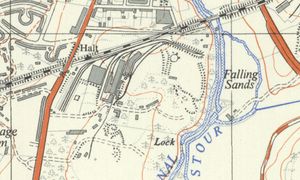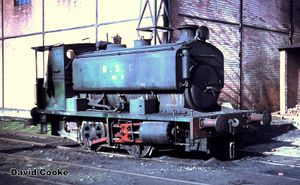Foley Park sidings
Foley Park sidings, located 1 mile 179 yards from Kidderminster Junction, were built in 1925 to serve the British Sugar Corporation factory at Foley Park. The sidings also provided a rail connection for the private sidings of Thomas Vale & Sons and Smethwick Drop Forgings. They were located near Foley Park Halt, which was moved from the south side of the line to the north side when the sidings opened. The sidings remained in use after the closure of the Kidderminster-Bewdley line on 6 January 1970, finally closing on 25 October 1982.
Contents
Operations and shunting locomotives
Access to the sidings from Kidderminster was by means of a ground frame. See Ground Frames at Foley Park. At opening, the factory included siding accommodation for about 118 wagons. Accomodation for about a further 100 wagons was built nearer Kidderminster Station at the junction with the main line.[1] By 1927, there were plans to provide a shunting spur and additional sidings.[2]
During the sugar beet season, which normally ran from mid-September to mid-January, up to four trains per day would arrive at Kidderminster. Shunting from Kidderminster to the Foley Park factory required a shunting engine from Kidderminster Shed to be available 24 hours per day.[3]
The BSC factory employed three Andrew Barclay 0-4-0ST shunting locomotives[4]:
- B.S.C. No.1, works no 1843/1925
- B.S.C. No.2, works no 1931/1927
- B.S.C. No.3, works no 2248/1948
All three were at Foley Park from new, with No. 3 arriving as part of a goods train on 1 May 1948.[5]. No. 2 was later transferred to the Wissington sugar factory at Kings Lynn, Norfolk in 1962. Steam working ended in January 1969, with No. 1 being sold for scrap in June 1969 and No 3 also being transferred to Wissington at the same time. No 2. is now preserved at "Rocks By Rail" and No 3. is now preserved at the Plym Valley Railway.[note 1]
The factory later employed two diesel shunters[4]:
- 0-4-0DE R&H works no. 408866/1959 (arrived 1961, scrapped October 1983)
- 0-4-0DM R&H 281269/1950 (arrived January 1969, preserved on the SVR September 1983)
Preservation
In January 2016 the area was cleared of undergrowth to allow surveying on behalf of the Wagon Review Group for a potential new wagon storage facility to provide covered accommodation for the SVR's fleet of wagons along with a PW storage area and access for locomotives arriving by road.
Historic maps of Foley Park sidings
- GWR plan of the northern part of Foley park sidings including Foley park Halt
- GWR plan of the southern part of Foley park sidings including the sand sidings on the opposite side.
- 1927 map showing the sidings and beet sugar factory
- 1938 map showing the sidings and the expansion of the beet sugar factory. The private sidings for Thomas Vale & Sons extends towards the bottom of the map
Photographs
- A DMU at Foley Park Halt. Comments on the link point out that the lack of traffic is likely due to sugar beet being a seasonal crop.
See also
Notes
- ↑ Several websites including the Plym Valley and "Preserved British Locomotives" refer to 2248 as being based at BSC's "Worcester & Somerset plants". Worcester presumably refers to Worcestershire, ie Foley Park; the reason for the reference to Somerset is unclear.
References
- ↑ Great Western Railway Magazine, September 1926
- ↑ Great Western Railway Magazine, June 1927
- ↑ Turley (2005) p. 72-77.
- ↑ 4.0 4.1 Railways in Worcestershire
- ↑ Turley (2005) p. 76.
- "Severn Valley Railway". Railways in Worcestershire article. Link. Accessed 09/01/2015.




